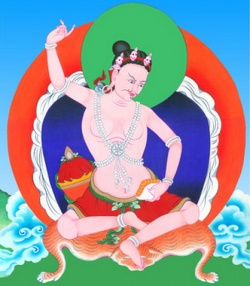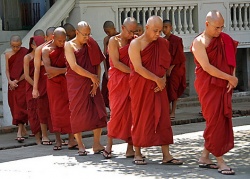Buddha Miracle Days
The 15 days following Losar are called the Buddha's Miracle Days. Buddha Shakyamuni performed many miracles for fifteen days after Losar in order to bolster the devotion of disciples.. This is considered an auspicious time in Tibetan Buddhism, when all activities, both positive and negative are multiplied millions of times. It is a good time to make offerings for loved ones, to help those in need, and in general, to do deeds beneficial to all sentient beings.
The first full moon of the year is celebrated in the Vajrayana tradition as the Day of Miracles, or Chotrul Duchen in Tibetan, to commemorate the final day of the 15 days of miraculous display by the Buddha. He performed the miracles during this time to overpower the six teachers of non-Buddhist views, called Tirthikas, who challenged him. When the Buddha first received the challenge, he moved to another kingdom of India[where?] and he continued to avoid the teachers until he had visited all the kingdoms. Finally, he had the kings of these lands and their retinues accompany him to the final kingdom[where?]. There, at an arranged field, he allegedly displayed his miraculous powers for 15 days to increase the devotion and merit of future disciples. Through these acts, which are observed annually by the prayer festival of the Gelugpa Monlam Chenmo, the Buddha defeated the teachers.
The clean water
Gautama Buddha asked his disciple Ananda to get him some drinking water from a well. Ananda, however, repeatedly told the Buddha that the well was filled with grass and chaff, and thus not drinkable. Despite this, the Buddha continuously asked Ananda for the well's water; eventually, Ananda went to the well. As Ananda walked to the well, the Buddha allegedly expelled all the grass and chaff from the well which resulted in the water becoming radiant and clean.
Walking on water
It is recounted as one of the Miracles of Buddha that Gautama Buddha walked on water by levitating over a stream in order to convert a brahmin to Buddhism.[2]
Power over nature
R.C. Amore recounts a miracle from the first chapter of Mahavagga (Book of the Discipline, IV) where the Buddha displayed his power over nature. When an area was inundated by a flood, he commanded the waters to stand back so that he could walk between them on dry ground.[3]
The golden bridge
During the third week after The Buddha's Enlightenment, the devas were unsure about whether Siddhartha Gautama had truly attained enlightenment or not. As proof of his enlightenment, The Buddha, using only his mind, allegedly created a golden bridge in the air, and walked up and down the bridge for an entire week.
Twin miracle
After the Buddha returned to his father's kingdom, uncertainty still existed about whether Gautama Buddha was really enlightened or not. In response, the Buddha allegedly displayed the Yamaka-pātihāriya or the "Twin Miracle", called so because of its simultaneous production of apparently contradictory phenomena; in this case, fire and water.
The twin miracle entailed Gautama Buddha producing flames from the upper part of his body and streams of water from the lower part of his body, alternating this, and doing similarly between the left and right sides of his body.
Afterwards, the Buddha took three giant steps, arriving in Tavatimsa. There, he preached the Abhidharma to his mother who had been reborn there as a Deva named Santussita.
Brahma
On one occasion, the Buddha allegedly flew into a Brahma's world, and explained to the Brahma that all things are transient and temporary and devoid of independent existence. After being persuaded by the Buddha's words, the Brahma decided to follow The Buddha's Dharma.
The Brahma then requested a competition of powers between the two of them. Whenever the Brahma hid himself, the Buddha ended up pointing out where he was located. Then, the Buddha hid himself in voidness and meditation but the Brahma could not spot him. The Brahma's faith in the Buddha was increased.

